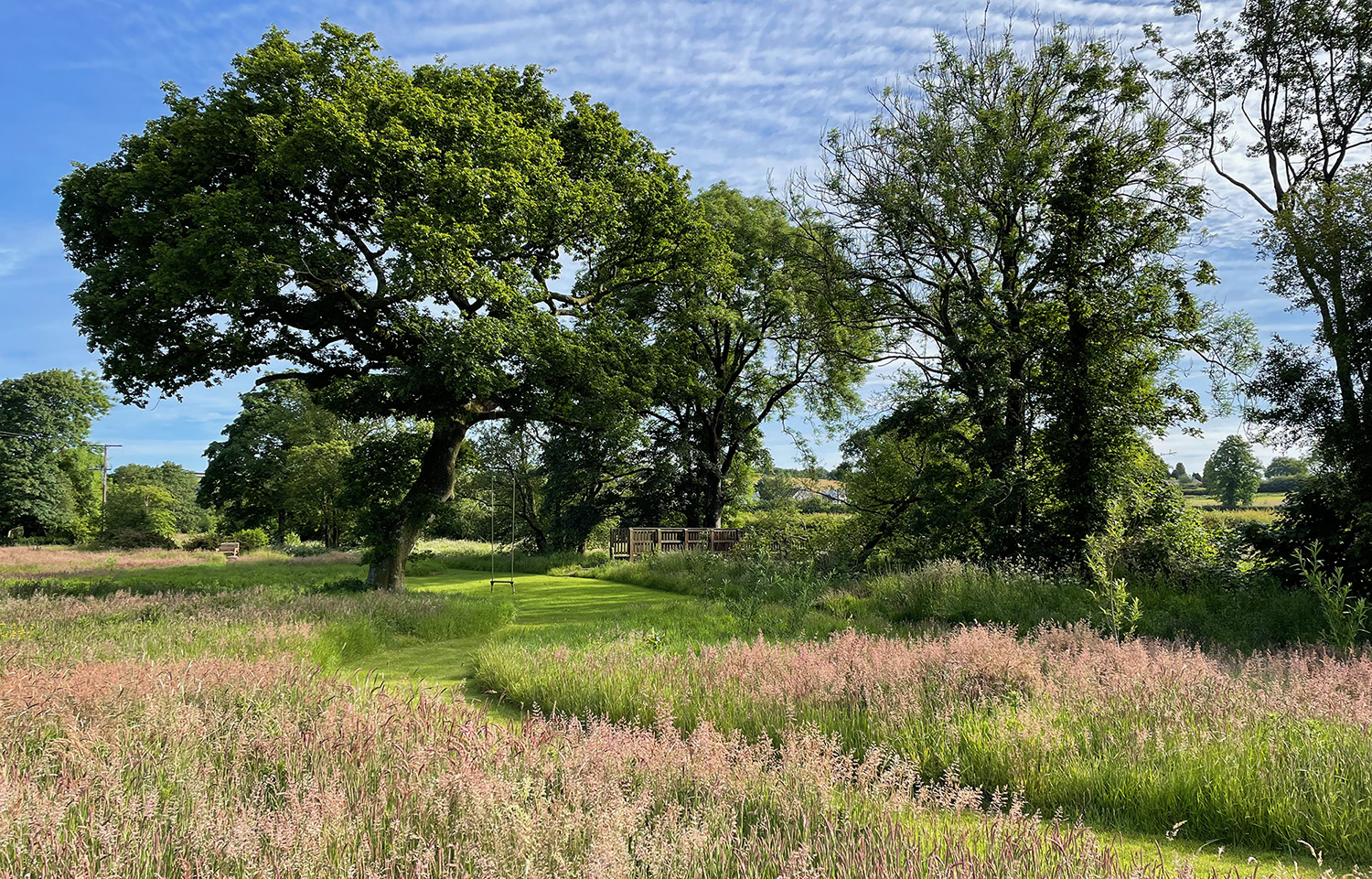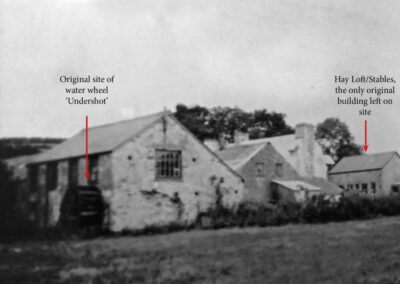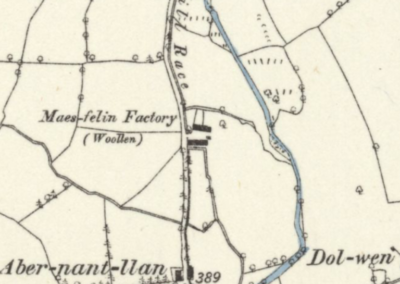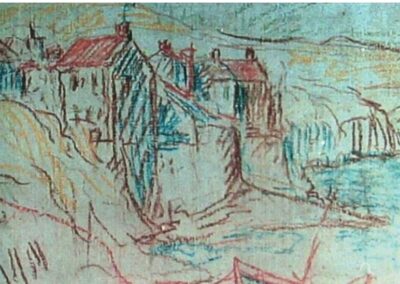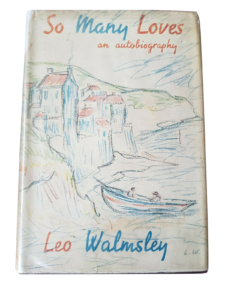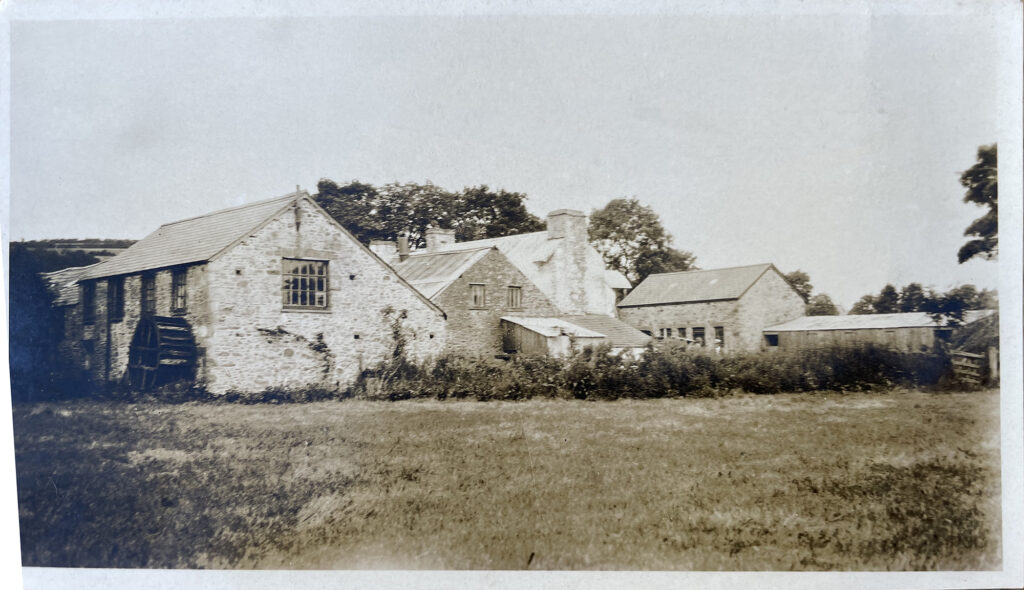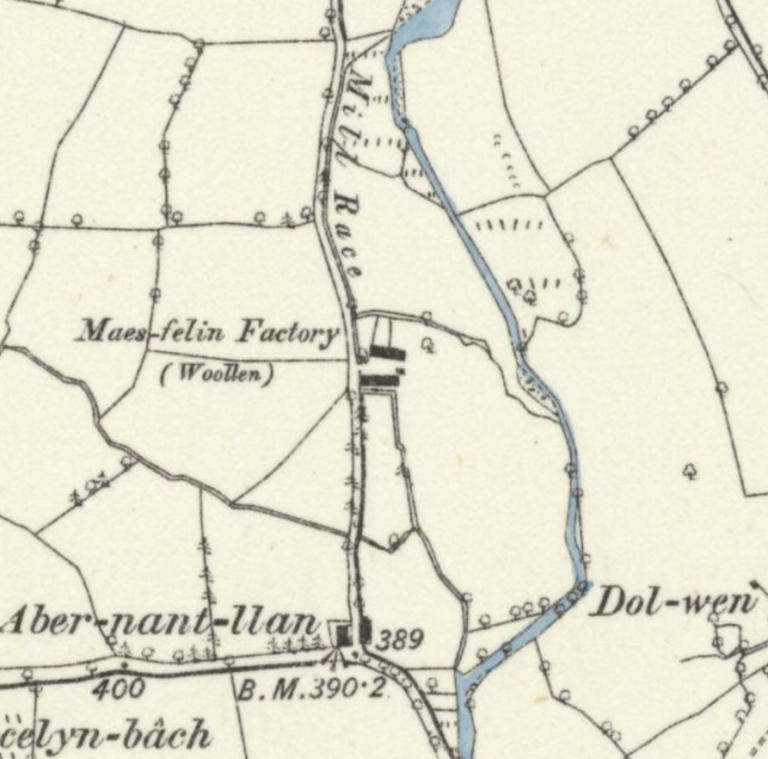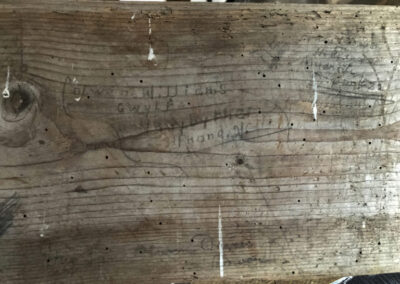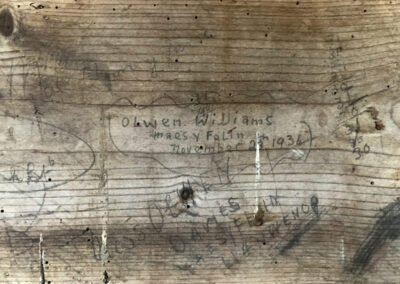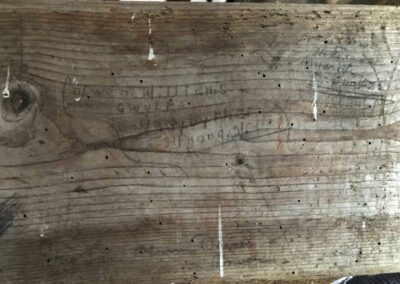Maesyfelin Isaf
History
Whilst we have lived here I have had a chance to uncover some of the local history involved with the old woollen factory/mill that used to stand on this site and those that lived here, courtesy of a neighbour Hazel and the Walmsley Society, who wish to preserve the art and writings of Leo Walmsley the author. But also let’s not forget the faithful Gooogle search engine.
The Maesyfelin mill and original house circa 1834, predominantly making wool blankets from what I can establish, in its most complete state I would guess. The unusual thing here is the location of the waterwheel, as this is not the correct siting, looking closely it looks too high and in a poor state, so maybe its on old wheel that had been replaced. The building to the right in the photo is the only bit still standing which is the stable/coach house and Hay Loft and is todays Glamping accommodation. Plus you can make out a ‘shed’ to the right of the stables and Hay Loft.
At around this point in history Maesyfelin was also a 16 acre farm, which went up to the bridge on the main road and as such the mill race could connect with the river/stream north of the property of today. Since then though the mill race has become disconnected with the river and more recently the small stream that ran down the hill to the west that used to contribute has also been redirected. So the only water that flows along the mill race today is road run off and I assume excess water from the small stream.
Also found out from the son of one of the contractors that helped in the initial rebuild, that at about the time the ‘Jenkins’ bought the property in the early 80’s, the council decided to widen the road by removing the old field hedge and were going to pipe the stream/mill race and road water run off, directly down to the river. But Peter Jenkins in his wisdom convinced them to pipe it to the waterwheel so he could get it going again. Mmm… not sure sure about the logic here as the amount of silt now going to be introduced and the infrequent flow water made it bad decision to my mind, especially as the tail race culvert pipe exiting from the wheel-pit is over two foot above the floor of the wheel-pit itself, so effectively not only restricting the free flow of water as it tries to exit but that it became a silt trap. Basically the Nant Cledlyn to which the tail race drains into a few hundred yards downstream, has risen (silted up) over the years, so that 2′ odd discrepancy in the culvert pipe height was because it needed to be that high in order for it to drain out to the river, which should have been enough to say that getting the waterwheel working again with what was effectively a ‘sump’ was a terrible idea.
I can only assume that when they moved the wheel from its original location which was further away from the road as pictured and turned it into an overshot wheel nearer to the road, that as opposed to the undershot which it had been originally, that they had no idea about hydrodynamics.
The main entrance to the place has changed, as it used to come in where we now have the lawn in front/south of the house and very little of the old mill remains.
The Woolen Mill Geneology
Over the Years
I have recently been able to update this thanks to John Bowen, whose grandfather was William Bowen B1885, who has been in contact and sent me a copy of his ‘The Bowen Family Story’… from which I am referencing.
Late 1700's
David Bowen,
Earliest Record of
Maesyfelin Farm
The earliest reliable records go back to the late 1700’s with John Bowen (1744-1808) who married Mary Evans (1758-1823), probably living just up the hill at Croesgwenllian Farm and had a son David Bowen (1784-1830).
David and Gwenllian: who owned Maesyfelin with his wife Gwenllian Evans (1782-1857) and had 11 children together, but only 6 children made it to adulthood.
Early 1800's
Thomas Bowen
Their son Thomas (1829-1906) ran the woollen mill with his dad and became head of the family around 1861. Whilst one of their daughters Mary Gwenllian (1819-1879) married a local strict Baptist chap from Llandysul named Titus Lazarus Davis who later emigrated to America as a Mormon with some of the children leaving Mary behind, which at the time was a terrible thing for her and she died in the poorhouse at the age of 60.
Thomas and Ann: Thomas (1829-1906) married an Ann Jones (1830-1882) and had four children William (1853-1932) married Mary Ann Thomas and moved to Iowa USA, David (1855-1911) married Elizabeth Thomas (1855-1919) moving to Cilcenin and Mydroilyn, Rachel (1857-1885) and Thomas (1870-1931) married Elizabeth Davies, who was a flax dryer at the mill. At this time his occupation in the census is shown as clothier and farmer of 16 acres and they employed a farm servant Ann Jones aged 16. In 1891 they also employed a House keeper and domestic servant Esther Jones.
Late 1800's
William Bowen in USA

Nashua Iowa Woolen Mill
As William had emigrated to Iowa USA, an ex work colleague of mine now living back in the States called Leah found an article for me which stated…. Nashua had one of the few successful woolen mills in Iowa, which was owned by William J. Bowen & Son. Local wool was spun into six grades of thread used to manufacture a large range of products, from the finest cloth to the coarse horse blankets. The United States Navy contracted 200,000 blankets in September of 1919 at Nashua Mills. After a disastrous fire in September of 1923, and again in November of 1926, the factory moved to Cedar Falls.
1906
Thomas Bowen takes over mill
In the 1891 census Anne disappears, with Thomas (1829-1906) now 62, with one of their other sons also named Thomas (1870-1931) who became head of the household in 1906 when his dad died, as the other son David had moved away. Although strangely the probate was split between Thomas and a reverend David Davies Evans.
Thomas and Elizabeth: The young Thomas (1870-1931) appears on the 1911 census as an adult and family head married to Elizabeth, who by all accounts was Elizabeth Davies back in 1901, when she was a flax dyer working at the mill and the daughter of the Davies family from the Pen Pom Pren Inn just up the road. It was in the 1901 census that Thomas is shown as a wool manufacturer. The 1911 census shows Thomas and Elizabeth living at Maesyfelin with their son Thomas Ifor (1908-2003) aged 2 at that point and that they employed two domestic servants and two flannel weavers at the mill. They may also have been involved with the Grain mill at Drefach which I understand to be in the Davies line.
In October 1906 Thomas purchased the share of the Maesyfelin estate that had been left to Reverend David Davis Evans when his father had died. Then in 1908 their son Thomas Ifor (1908-2003) was born, in 1911 their second son Di (David) Augustin (1911-?) was born and then in 1912 a daughter Anne Elizabeth (1912-2004) pictured below.
1912
Thomas Bowen
In 1912 Thomas built a big new house on the opposite side of the road to the mill, which is now Maesyfelin Care Home and it must have been at this point that Maesyfelin Mill as it was known became Maesyfelin Isaf (meaning lower). Then in 1916 Thomas gifted some of the land to the district council to enable widening of the road
1931
Elizabeth Bowen
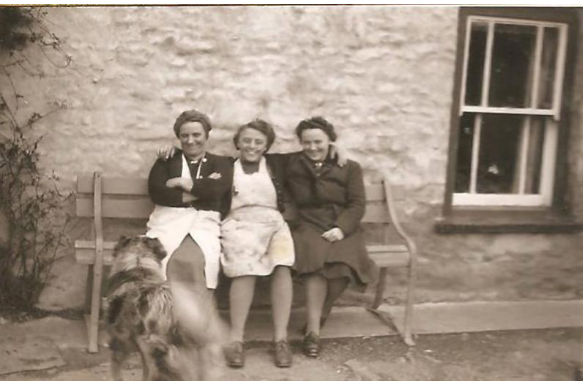
Anne Bowen (on the right) outside Pen Prom Pren Inn (Pint-of-Hstory.Wales)
When Thomas died in 1931 he left everything to Elizabeth, with the last entry I can find in 1939 with Elizabeth now 59, with daughter Anne Elizabeth Bowen born 1912, and reverend Austin (Di Augustin?) Bowen denoted as a farm labourer and Ifor (Thomas Ifor?) Bowen.
1944
Leo Walmsley link

The war and post war years are a bit sketchy, other than it would seem the mill may no longer have been in use with the family (Anne, Ivor and Austin) living in the ‘new’ main house which is now the care home over the road. But obviously had a strong bond with the Davies family line, as it was whilst staying at Pom Pren Pren Inn that the author Leo Walmsley apparently wrote some of his book ‘So Many Loves’ in 1944, whilst stationed in the local area. Which was (and still is) ran by a family connection to Maes y Felin on the Davies side and he was allowed to use an empty barn loft as his studio being somewhere quiet to write his book. I now have an original copy of this book, just for completeness, which guests are welcome to read during their stay.

Flight Sergeant Ivor Bowen
We recently knocked down the ramshackle old crinkle tin garage and whilst sorting through the wood pile for good stuff that we could still use, the corner of of my eye picked up something. Upon taking a closer look it was a little bit of history, probably to signify when the ‘garage’ was built and by.
Flight Sergeant Ivor Bowen
RWP or Mrs Jones
27th March 1944
Mrs Ivor Bowen (supervisor)
Apparently he flew Spitfires during the war, with honours and sadly passed away in 2003.

Leo Walmsley, Old Barn Torn Down
Now many of you may look at the book’s cover and wonder why it’s a sketchy picture of Robin Hoods Bay, well firstly that was his home town but also early sketches were found here on site.
In the mid 1980’s when Maesyfelin Isaf as you see it today was being built, the Walmsley society came to visit the old barn before it was knocked down and I have a picture courtesy of the Walmsley Society to illustrate this, that shows its origins sketched on the wall in the same barn.
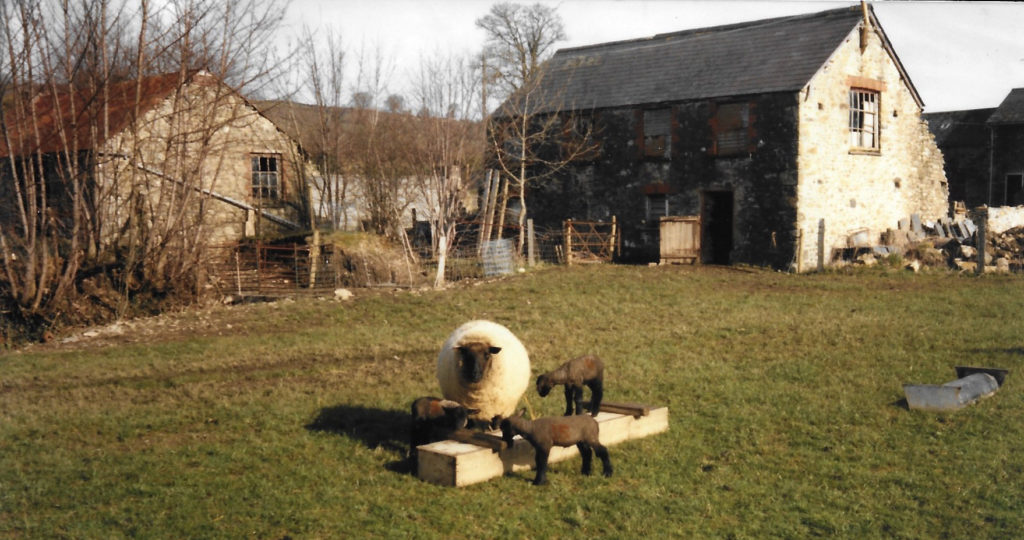
1980's
It was sometime around the 80’s that the Maesyfelin, as a whole, was sold and it would seem broken into smaller lots with maesyfelin Isaf being sold off separately to become what it is today, land upstream was developed with four bungalows being built on the land and what was the main house at some point became Maesyfelin Care Home.
Recent History
In the 1980’s it was owned by Peter and Daphne Jenkins who bought it in 1980 from Mr and Mrs E. P. Liani, although at that time it included the land up to the point where the mill race joined the Nant Cledlyn, which he must have sold off as there are now four bungalows built on that parcel of land.
During the Jenkins tenure they did an excellent job of building most of what you see today, including the ‘Annex’ which they built in 1982/83 (as discovered under wallpaper) to live in whilst they worked on the house, which was signed off in 1985/6 by all accounts. These three photos, courtesy of Neil Copage, relative of Daphne.
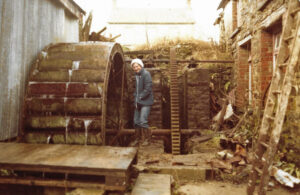
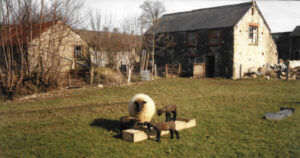
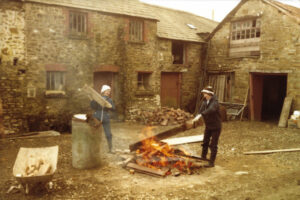

More recently it became obvious that the waterwheel had to come out before it rusted away, as covered earlier in this article. But basically it sat in 2′ to 3′ silt because the tail race culvert pipe was above the floor of the wheel-pit itself, so decided to offer it out via Facebook and Gumtree to a new home. To keep it short the wheel now resides near Dihewyd which is the other side of Lampeter, where it will be put back into operation again after a bit more work on his old mill building, as opposed to being a garden ornament that will eventually rot away.

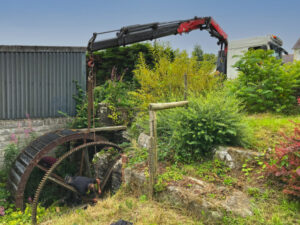
If you want to see the video of the lift see Video Link.
One of the interesting ‘artefacts’ that we have come across, is a fair bit of graffiti which can be found written on some of the wood that makes up the hay bins in the stables under the Hay Loft, that were done in the pre WWII years.
Many thanks to John Bowen (Grand Son of William Bowen), Hazel Thomas (Relative in the Davies line), Marilyn Barraclough and Jane Ellis (Walmsley Society), Joy Bennett (Grand daughter of Thomas Bowen), Neil Copage (relative of Daphne Jenkins) and Leah Mitchel-Dawson (friend in Iowa and helps me with the website) for their help in me writing this article.
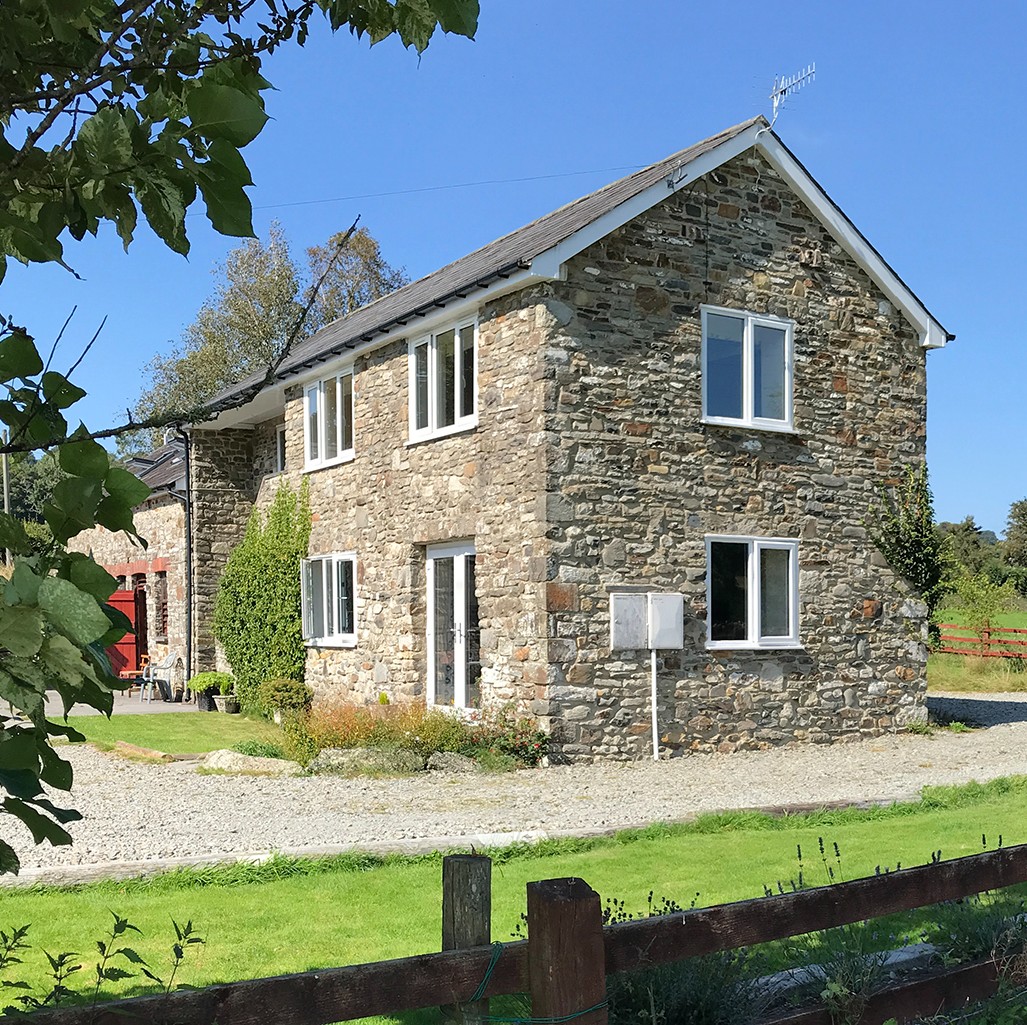

Become Part of Our story
